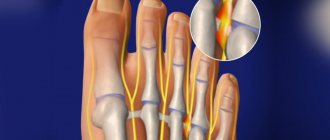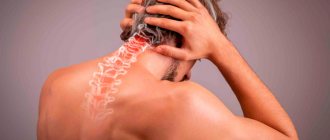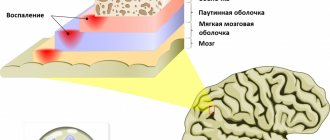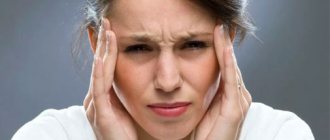Signs that pain in the cervical region is radiating to the head
This symptom is usually characterized by initial pain in the neck, after which it “shifts” to the head. Neck pain is most often caused by various pathological processes occurring in this area:
- inflammatory;
- degenerative-dystrophic;
- traumatic origin.
Headaches that occur due to problems in the cervical spine are called cervical. It is different from “classic” migraine. Cervical pain is usually defined as dull pain, often localized in the back of the head, but sometimes spreading to the temples and eyes. Even less commonly, it appears in the upper part of the head (forehead and crown), as well as in the ear area. This pain is often accompanied by:
- stiffness and pain in the neck (when trying to turn the head);
- tingling or numbness in the shoulder girdle and arms;
- dizziness (with nausea);
- ringing in the ear;
- inability to concentrate;
- muscle weakness;
- depression.
According to the nature of its manifestation and connection with the provoking pathological mechanism, cervical pain can be:
- arteriospastic (aching pain is observed in all parts of the head);
- arteriodilatatory (pain of a pulsating nature is localized in the temples and back of the head);
- venous (pressing pain in the morning);
- muscular-tonic (aching in nature, encircling the parietal region with a “hoop”);
- liquor-hypertensive (bursting in nature with pressure on the eyes);
- neuralgic (with attacks of “shooting” pain).
Pain in the temple area
Arthritis
6791 28 October
IMPORTANT!
The information in this section cannot be used for self-diagnosis and self-treatment.
In case of pain or other exacerbation of the disease, diagnostic tests should be prescribed only by the attending physician. To make a diagnosis and properly prescribe treatment, you should contact your doctor. Pain in the temple area: causes of occurrence, what diseases it occurs with, diagnosis and treatment methods.
Definition _
Pain in the temple area is one of the most common complaints that brings patients to the doctor.
In the bone structures of the skull and brain tissues, pain sensitivity is insignificant, so the main sources of pain are blood vessels, meninges and cranial nerves.
Types of pain in the temple area
According to the International Classification of Headaches 3 (2013), all headaches are divided into:
- for primary pain not associated with diseases of the brain and other structures of the head and neck;
- secondary pain associated with other diseases;
- painful cranial neuropathies, other facial and headaches.
Possible causes of pain in the temple area
Arterial hypertension
is one of the common causes of headaches in the back of the head and temples. When pressure increases, attacks of headaches occur, which may be accompanied by nausea, vomiting, and “spots” before the eyes.
Tension headache
– one of the common reasons for visiting a neurologist and therapist. Patients characterize it as squeezing, pressing.
Tension headaches interfere with quality of life and performance, despite the fact that they are considered benign and do not carry serious consequences.
Migraine
is the most common form of attack-like headache.
Migraine is characterized by localization of pain in the temporo-frontal-orbital region and a paroxysmal nature of the course.
If the pain is not paroxysmal, then it is not a migraine. Seizures can occur on one side of the head or on both sides, and can also change their location (right-left).
A headache attack can occur at any time of the day, more often during a night's sleep in the morning or after waking up. The pain is pulsating, bursting, with a gradual increase in intensity over several hours. Before the onset of an attack, a so-called aura is possible (harbingers of pain, they vary from person to person, but are often described as disturbances in vision, speech, or dizziness). The pain intensifies in bright light, from loud sounds and other irritants, including changes in head position. The attack can last up to several days.
Harris' periodic migraine neuralgia
- characterized by the sudden onset of pain in the eye area on one side and spreading to the temporal, frontal and zygomatic areas, and sometimes even to the neck.
Unlike migraines, there are no warning signs of pain.
The pain is burning, cutting, bursting, accompanied by redness of the eye and lacrimation on the painful side. Some patients experience a sensation of the eye “bulging out of its socket.” All these attacks are characterized by a certain seasonality or periodicity. The duration of the attack ranges from 6–8 weeks to 3 months.
Pain in the temple area may occur immediately after drinking cold water
or ice cream due to arterial spasm. In this case, the pain is aching, squeezing, sometimes throbbing.
Cold pain occurs in individuals with increased sensitivity to cold stimuli and high reactivity of the body.
“Sausage” headache
(in English-speaking authors -
hot dogs headache
) occurs when eating foods containing food additives such as sodium nitrate. During a chemical reaction in the body, nitrate is converted into nitrite, which has a vasomotor effect (controlling the process of contraction and relaxation of the muscular lining of the walls of blood vessels, and, consequently, the lumen of blood vessels), and sensitive people may feel pain in the frontotemporal region.
A similar effect sometimes occurs when eating Chinese dishes (“Chinese restaurant headache”), where monosodium glutamate is often used.
Giant cell arteritis
is the most common systemic vasculitis in the world, affecting large vessels. The favorite localization of this disease is the temporal artery. Most often, the pain is intense, accompanied by limited function of the corresponding temporomandibular joint, blurred vision with its gradual decrease, and a hardened artery in the temple area is detected.
Without treatment, it can lead to permanent blindness of the eye on the affected side.
With inflammatory diseases of the ear,
pain in the temporal and parotid region is possible, which is accompanied by fever, redness, swelling in the ear area, and purulent discharge from the ear.
Meningitis
develops when an infectious agent enters the membranes of the brain, followed by an inflammatory process.
The headache is sudden, sharp, diffuse, predominant in the frontotemporal areas, sometimes accompanied by vomiting.
Neuralgia of the auriculotemporal nerve
often occurs after an inflammatory process or traumatic lesion of the parotid gland. It is characterized by burning, throbbing pain in the area of the external auditory canal, temple, temporomandibular joint, radiating to the lower jaw. The pain is accompanied by increased salivation and redness of the skin over the affected area. Attacks are triggered by eating and smoking.
Neuralgia of the ear ganglion
manifests itself as attacks of burning pain in the temporal region lasting from several minutes to an hour. May be accompanied by ear congestion and increased salivation.
For altitude sickness
There is a change in arterial tone due to reduced oxygen pressure and changes in barometric pressure. Headache is accompanied by shortness of breath, palpitations, and blurred vision.
The severity of symptoms depends on the speed of ascent to altitude.
The pain is relieved by applying cold to the temples and drinking cool water.
Traumatic lesion of the temporal region
may be the cause of pain. This includes a wide group of pathologies: fracture of the temporal bone, dislocation of the temporomandibular joint, soft tissue contusion.
Subarachnoid hemorrhage
occurs for various reasons, for example, as a result of a rupture of a cerebral aneurysm, a person feels like a strong blow to the head, hot liquid pouring into the head, strong contraction, and then bursting. The pain may initially be localized in the corresponding part of the head - in the temporal region when an aneurysm of the internal carotid artery ruptures.
Damage to the temporomandibular joint
(both inflammatory - arthritis, and non-inflammatory - arthrosis, malocclusion) may be accompanied by pain in the parotid and temporal region. When moving the lower jaw, crunching and clicking may occur in the joint; the pain intensifies when chewing and during conversation.
Which doctors should I contact if I have pain in my temples?
If you experience intense and recurring pain in your temples, you should consult a specialist.
If pain persists after taking painkillers or other symptomatic treatment previously prescribed by your doctor (for example, to lower blood pressure), and there are no signs of injury, you should contact or. Depending on the accompanying symptoms, you may need to consult a neurologist, rheumatologist, otolaryngologist, or ophthalmologist. In case of previous injury, it is necessary to contact a traumatologist or to exclude severe injury.
Diagnostics and examinations for pain in the temples
The list of examinations is prescribed by the doctor depending on the indications. An approximate list of studies that may be prescribed:
- computed tomography of the head;
Who more often experiences pain in the cervical spine radiating to the head?
This symptom does not depend on race, gender, or age. Moreover, it is usually more often observed in people aged 20 to 60 years and older (since it is directly related to the development of cervical osteochondrosis, which affects almost 90% of people after 65 years). According to statistics, cervical pain is most often recorded in those who:
- has a sedentary job in an office at a computer;
- works professionally as a driver;
- associated with regular strength loads (professionally or in sports);
- has chronic problems with normal cerebral circulation;
- suffered injuries to the cervical spine;
- has a genetic predisposition.
What diseases cause pain in the cervical region to radiate to the head?
The most common causes of this symptom are the following diseases or pathological conditions:
- cervical osteochondrosis – observed in almost 90% of elderly people, which is associated with age-related deformation of the bones and cartilage that make up the cervical spine, with severe pain localized at the base of the skull, in the temples, often accompanied by decreased vision (against the background of eye “fatigue”), can also develop due to a passive lifestyle, excess weight or genetic predisposition;
- spinal injuries – including microtraumas received from impacts, falls during sudden braking or acceleration while the vehicle is moving;
- circulatory disorders - due to hypertension, or insufficient blood flow to the brain due to atherosclerosis of the vertebral artery;
- cervico-occipital neuralgia - pain spreads along the head, covering the temples, eyes and forehead (in the direction of the affected nerve);
- stress and physical or mental exhaustion - neck pain radiating to the head, in this case, serves as a prerequisite for the development of osteochondrosis.
Why it shoots in the left temple: 18 common reasons
If the left temple hurts and throbs, this may be a concomitant sign of a number of disorders. As a rule, trouble occurs under the following conditions:
- Physical and emotional fatigue . People who are stressed and lead an unhealthy lifestyle often experience headaches, and their face may go numb during an attack. As a rule, the painful condition lasts for 1–2 hours, after which improvement occurs.
. A situation where a headache and shooting in the left temple often occurs in adolescents and young women, especially during pregnancy. Often the malaise is accompanied by visual disturbances, and “spots” flash before the eyes, and some patients experience nausea, vomiting and an increased heart rate.
Migraine- Premenstrual syndrome . During these periods, neuroendocrine changes occur in a woman’s body, one of the manifestations of which is pain in a certain part of the head.
- Disruptions in the production of hormones . This process can manifest itself as sharp pain in the back of the head, temples or frontal area. Often such attacks occur in women during menopause, accompanied by hot flashes and mood swings.
- Inflammatory processes and infectious diseases . With influenza and ARVI, severe pain in the head often occurs, disappearing after recovery. These same symptoms are characteristic of colds, when the patient could simply be exposed to a draft. In such cases, pain may appear not only in the temples, but also in the neck or ear.
- Poisoning . During intoxication, in addition to nausea and vomiting, an unpleasant sensation often occurs when the right or left temple throbs and severely hurts. The same symptoms are characteristic of a hangover.
- Atherosclerotic plaques in the vessels of the brain . Such “deposits” are often the cause of pain that knocks in the left temple , and can periodically intensify and then subside. Such conditions are accompanied by disorders of hearing, vision, memory and coordination of movements.
- High or low blood pressure . These conditions may be accompanied by loss of consciousness, weakness, arrhythmia and pulsation in the right or left side of the head.
- Diseases of the adrenal glands . This condition is characterized by increased activity of adrenaline synthesis, resulting in vascular spasms and blood pressure “jumping up.” This provokes the disease.
- Vegetovascular dystonia . This disorder can be accompanied by unpleasant manifestations from all organs and systems of the body, including headaches.
- Osteochondrosis of the cervical spine . Due to this disorder, the diameter of the vertebral artery decreases, which can cause discomfort when the head hurts and the left temple twitches.
- Diseases and injuries of the facial joints . With such a disorder, pain appears in the corresponding part of the head, as well as in the cheekbones. Sometimes when the jaw moves, clicks occur and a crunching sound is heard in the joints.
- Damage to cranial nerves . This condition is caused by compression of the processes, which provokes sensations reminiscent of an electric shock.
- Chronic inflammation of the temporal arteries (arteritis) . This disease affects older people: both women and men. The condition is manifested by pain in the temple area, which is often pulsating in nature. In some cases, there is redness in this part of the face.
- Infectious and inflammatory diseases of the oral cavity . Many patients note that when a tooth hurts, the unpleasant sensation spreads throughout the entire head, including the temporal region. The same thing happens with painful processes in the mucous membrane, for example, stomatitis.
- Inflammation of the meninges . These conditions are characterized not only by headache and fever, but also by symptoms accompanying poisoning.
- "Hungry" pains . People who eat irregularly or practice strict diets are prone to frequent ailments in the form of headaches. This is a consequence of a lack of certain microelements in the body.
- Food headaches. This is the opposite situation, when the disease occurs in people who abuse certain foods, for example, fast food, chocolate, Chinese processed foods, cheeses, and others.
Which doctor should I see?
If pain in the cervical spine radiates to the head , it is better to immediately contact a neurologist (or orthopedist-traumatologist) to accurately diagnose the current condition and identify the causes of pain in the neck and head. This is especially true for pain that does not stop for several days or often recurs.
Are you worried about neck pain that radiates to your head? Don't waste your time. Qualified medical specialists are always ready to determine the exact cause of your illness and return you to the true joy of life without pain as quickly as possible!









